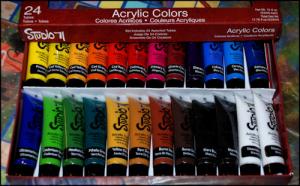Looking for design inspiration? Browse our curated collections!
May 12th, 2015 - 04:58 AM

Getting started
Acrylics are one of the most popular types of paints because they dry very quickly and can be diluted with water to create a watercolour effect. They are very good at protecting a piece of art because they resist water very well, despite the fact that they can be diluted with it. They also show no signs of discolouring, fading or cracking. Beginners often start off with acrylics and take it from there.
So much choice!
The main problem is that there are so many different supplies available. It can be overwhelming for a beginner to decide what to buy and how much of each item is needed. As long as you have the essentials, you should be all sorted. Basic supplies work just fine for beginners, whether the budget is big or small. As artists get more accustomed to acrylic painting and become more adventurous in their work, they tend to then get specialist supplies that meet their exact needs.
What youíll need
The most important basic tools you will need are acrylic paint, a paintbrush and a surface to paint on. Youíll also need an easel, a palette, an empty jar, a spray bottle and some paper towels. As well as these you might also need some running water and some protective materials. All of these basic supplies can be found at any good art supplies store and there are loads of websites offering good deals for supplies as well. Note that online shopping tends to have cheaper prices and a bigger variety of products.
How many colours will I need?
It can be difficult determining exactly how many colours are going to go on your palette. Itís probably harder deciding what colours are going to go on it. For a basic, beginnerís palette you should probably have white and the primary colours, red, blue and yellow. Add a few different shades in if you can, but if not, the three primary colours plus white should do just fine. Experiment with mixing and finding new colours. As you become more advanced, you can move away from mixing primary colours and focus on more specialist colours.
What type of paintbrush?
There are loads of different types of paintbrushes to choose from. The only way youíre going to find the one best suited to you is by giving several a go. Try out some different shapes, makes and sizes and see which one you feel most comfortable with. You should only need a few brushes to complete your painting. Brushes that shed their bristles easily tend to be cheaper, while the more expensive ones donít shed their bristles that easily.
What do I paint on?
The best painting surface for a beginner is a canvas. You donít necessarily need an easel if youíre prepared to paint on a flat, horizontal surface, but itís much easier having your canvas face you on an easel.
Whatís everything else for?
Have a spray bottle handy and every so often spray a bit of water over your palette. This keeps it from drying out faster. Youíll need a jar to store brushes and another, bigger one with plenty of water in to wash and rinse off your brushes. Before you get started, make sure all surfaces close by protective materials that you donít mind getting paint on, such as an old cloth. Have access to water so you can prime your jar and wash your hands. Paper towels are handy for wiping brushes and washing your hands with.
Get the basics and go from there
Donít let yourself get overwhelmed by the vast amount of different products out there. When you go shopping for supplies, just choose the basics and go from there. Once youíve got the hang of it, be adventurous: try different types of paintbrush, new colours and new surfaces to paint on. There are so many options, but itís always good to start off with the basics.
Have a look at my Instagram page. I'll be posting more photos soon.
Please subscribe to my email list here:
https://www.formstack.com/forms/?1934556-jwhBRxGL8x
Comments
There are no comments on this blog. Click here to post the first comment.